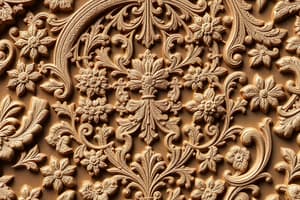Podcast
Questions and Answers
Which of the following is not typically used as a cutting tool material?
Which of the following is not typically used as a cutting tool material?
- Cold work tool steel
- Cast iron (correct)
- High speed steel
- Cemented carbide
What is the percentage of Molybdenum in M-series high speed steel?
What is the percentage of Molybdenum in M-series high speed steel?
- 12%
- 16%
- 24%
- 21% (correct)
Which alloy steel has the highest yield strength?
Which alloy steel has the highest yield strength?
- Low carbon steel
- Medium-carbon steel
- High carbon steel (correct)
- All of these
High tensile steel typically contains what percentage of Carbon?
High tensile steel typically contains what percentage of Carbon?
Which option is not a function of alloying steels?
Which option is not a function of alloying steels?
Which of the following materials cannot be remelted?
Which of the following materials cannot be remelted?
What is a primary characteristic of polymers?
What is a primary characteristic of polymers?
What material is known for its excellent corrosion resistance?
What material is known for its excellent corrosion resistance?
Which of the following is considered an amorphous material?
Which of the following is considered an amorphous material?
What do alloys consist of?
What do alloys consist of?
What is the maximum solubility of carbon in austenite (?-iron)?
What is the maximum solubility of carbon in austenite (?-iron)?
Which structure represents ferrite (?-iron) in the iron-carbon diagram?
Which structure represents ferrite (?-iron) in the iron-carbon diagram?
At what temperature does the eutectoid reaction occur in the iron-carbon diagram?
At what temperature does the eutectoid reaction occur in the iron-carbon diagram?
What is the term for the failure of a material under repeated load?
What is the term for the failure of a material under repeated load?
Which property allows a material to be drawn into thin wires?
Which property allows a material to be drawn into thin wires?
Which of the following materials is classified as brittle?
Which of the following materials is classified as brittle?
The capacity of a material to absorb energy and resist shock is known as what?
The capacity of a material to absorb energy and resist shock is known as what?
What is the slope of the creep curve highest in?
What is the slope of the creep curve highest in?
Which property is indicative of a material's ability to carry heat?
Which property is indicative of a material's ability to carry heat?
The amount of energy absorbed by a material before fracture is termed what?
The amount of energy absorbed by a material before fracture is termed what?
What is the general property of most metals?
What is the general property of most metals?
What is the primary goal of stress-relief heat treatment?
What is the primary goal of stress-relief heat treatment?
Which heat treatment is most appropriate for reducing brittleness in hardened steel?
Which heat treatment is most appropriate for reducing brittleness in hardened steel?
During tempering, steel is heated to a temperature:
During tempering, steel is heated to a temperature:
What is the primary benefit of quenching in oil compared to water?
What is the primary benefit of quenching in oil compared to water?
Which quenching medium provides the fastest cooling rate?
Which quenching medium provides the fastest cooling rate?
At what temperature is subcritical annealing performed?
At what temperature is subcritical annealing performed?
What feature differentiates induction hardening?
What feature differentiates induction hardening?
What is spheroidizing?
What is spheroidizing?
What is the recrystallization temperature of a metal typically expressed as a percentage of its melting point?
What is the recrystallization temperature of a metal typically expressed as a percentage of its melting point?
What is the main purpose of the austempering process?
What is the main purpose of the austempering process?
Austempering is typically applied to which of the following materials?
Austempering is typically applied to which of the following materials?
To what temperature range is the steel quenched during the austempering process?
To what temperature range is the steel quenched during the austempering process?
Which microstructure is primarily formed during the austempering process?
Which microstructure is primarily formed during the austempering process?
What is a significant advantage of austempering over conventional quenching and tempering?
What is a significant advantage of austempering over conventional quenching and tempering?
Which of the following is NOT a benefit of austempering?
Which of the following is NOT a benefit of austempering?
During the austempering process, which structure is notably avoided in the final microstructure?
During the austempering process, which structure is notably avoided in the final microstructure?
Which phase transformation occurs during annealing?
Which phase transformation occurs during annealing?
Hardening usually requires heating the steel above which temperature?
Hardening usually requires heating the steel above which temperature?
What is the major difference between annealing and normalizing?
What is the major difference between annealing and normalizing?
Which type of furnace is commonly used for heat treatment processes?
Which type of furnace is commonly used for heat treatment processes?
Which of the following is NOT a quenching medium?
Which of the following is NOT a quenching medium?
What type of heat treatment is often used for low-carbon steels to improve machinability?
What type of heat treatment is often used for low-carbon steels to improve machinability?
What does the term 'martensitic transformation' refer to?
What does the term 'martensitic transformation' refer to?
In carburizing, the steel absorbs carbon to form a hard surface at which temperature?
In carburizing, the steel absorbs carbon to form a hard surface at which temperature?
Flashcards
Hardness
Hardness
The property by virtue of which a material can resist scratching or indentation.
Ductility
Ductility
The ability of a material to deform under tensile stress without fracturing.
Toughness
Toughness
The ability of a material to absorb energy before fracturing.
Stiffness
Stiffness
Signup and view all the flashcards
Creep
Creep
Signup and view all the flashcards
Fatigue
Fatigue
Signup and view all the flashcards
Resilience
Resilience
Signup and view all the flashcards
Thermal Conductivity
Thermal Conductivity
Signup and view all the flashcards
Quenching
Quenching
Signup and view all the flashcards
Annealing
Annealing
Signup and view all the flashcards
Stress-relief heat treatment
Stress-relief heat treatment
Signup and view all the flashcards
Tempering
Tempering
Signup and view all the flashcards
Spheroidizing
Spheroidizing
Signup and view all the flashcards
Carburizing
Carburizing
Signup and view all the flashcards
Subcritical annealing
Subcritical annealing
Signup and view all the flashcards
Critical Temperature
Critical Temperature
Signup and view all the flashcards
Difference between annealing and normalizing
Difference between annealing and normalizing
Signup and view all the flashcards
Resistance Furnace
Resistance Furnace
Signup and view all the flashcards
Water Quenching
Water Quenching
Signup and view all the flashcards
Annealing for machinability
Annealing for machinability
Signup and view all the flashcards
Martensitic Transformation
Martensitic Transformation
Signup and view all the flashcards
Annealing for Cold-worked Metals
Annealing for Cold-worked Metals
Signup and view all the flashcards
What is a ferrous metal?
What is a ferrous metal?
Signup and view all the flashcards
What are polymers?
What are polymers?
Signup and view all the flashcards
What are stainless steels known for?
What are stainless steels known for?
Signup and view all the flashcards
What is an amorphous material?
What is an amorphous material?
Signup and view all the flashcards
What are alloys?
What are alloys?
Signup and view all the flashcards
What are refractory materials used for?
What are refractory materials used for?
Signup and view all the flashcards
What is the maximum solubility of carbon in austenite?
What is the maximum solubility of carbon in austenite?
Signup and view all the flashcards
What is the crystal structure of ferrite?
What is the crystal structure of ferrite?
Signup and view all the flashcards
High-speed steel
High-speed steel
Signup and view all the flashcards
High tensile steel
High tensile steel
Signup and view all the flashcards
Medium or High carbon steel
Medium or High carbon steel
Signup and view all the flashcards
Cold work tool steel
Cold work tool steel
Signup and view all the flashcards
Vanadium
Vanadium
Signup and view all the flashcards
Recrystallization Temperature
Recrystallization Temperature
Signup and view all the flashcards
Bainite
Bainite
Signup and view all the flashcards
Reduced Distortion
Reduced Distortion
Signup and view all the flashcards
Austempering Temperature Range
Austempering Temperature Range
Signup and view all the flashcards
Material Strength
Material Strength
Signup and view all the flashcards
Study Notes
General Study Notes
- No specific text or questions were provided. Please provide the material you would like summarized.
Studying That Suits You
Use AI to generate personalized quizzes and flashcards to suit your learning preferences.




